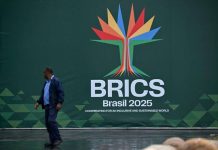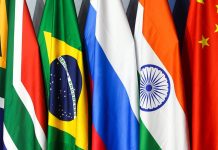
Kuala Lumpur – Malaysia and eight other nations officially became partner countries of the BRICS emerging nations grouping this month after the Southeast Asian nation filed its bid last July to join the 10-member economic bloc that includes Russia and China.
Although Malaysia’s bid for full membership was preceded by Indonesia, which was recently added to BRICS, the country is still believed to be one step away from formally joining the grouping. BRICS was originally founded by Brazil, Russia, India and China in 2009 and later expanded to include South Africa, with Egypt, Ethiopia, Iran and the United Arab Emirates joining last year.
While Malaysia’s application could be seen as a move away from the West, experts said the country, which maintains close trade ties with the Group of Seven nations, is aiming to boost economic engagement with the diverse group of member countries of the BRICS bloc. The move will require it to walk a fine line between the West and developing economies.
BRICS has begun discussing switching to trade in non-dollar currencies, bringing opposition and tariff threats from U.S. President Donald Trump ahead of his second inauguration in January.
However, not all the BRICS members nor all the nine new partner countries are apparently eager to pursue “de-dollarization” due to the time required to implement an alternative.
Russia’s Tass news agency reported on Jan. 2, citing the country’s Foreign Ministry, that nine countries including Indonesia, Malaysia and Thailand on Jan. 1 became BRICS partner countries, a new category created during a summit in Russia in October.
Brazil, which holds the bloc’s presidency this year, announced on Jan. 6 that Indonesia had been admitted as a full member. Nigeria was added as a partner country the following week.
Malaysian Prime Minister Anwar Ibrahim said earlier this month in Britain that he is trying to position his country “as a vital nexus of trade and investment” in an “unpredictable world.”
“It is through this forward-looking and holistic paradigm that Malaysia came to the strategic decision to join BRICS,” Anwar said.
Malaysia’s application to BRICS has raised questions about whether the country is pivoting further away from the United States and Europe.
Anwar, the leader of the Muslim-majority Malaysia, has been outspoken in his criticism of the West. He has labeled the weapons support provided to Israel for its conflict in Gaza hypocritical when Russia is being targeted with punitive actions, including sanctions, in response to its invasion of Ukraine.
Malaysia enjoys stable ties with China, despite their conflicting claims over territory in the South China Sea, while the Philippines has clashed with Beijing over a similar dispute. Anwar and Chinese Premier Li Qiang met in June, agreeing to recommit to bilateral discussions on the competing maritime claims.

Malaysian Prime Minister Anwar Ibrahim (R) meets Chinese Premier Li Qiang (L) in Putrajaya, Malaysia, on June 19, 2024. (Photo courtesy of the Malaysian government)
Qarrem Kassim, an analyst with the Institute of Strategic and International Studies in Malaysia, said the notion of Malaysia’s shift from the West to BRICS “oversimplifies its broader strategic approach,” pointing out that the country is party to the U.S.-led Indo-Pacific Economic Framework.
“Malaysia continues to position itself as a neutral and reliable partner for the United States’ and the EU’s semiconductor and high-tech investments,” he said.
The United States and the European Union are Malaysia’s third- and fourth-largest trading partners, behind the Association of Southeast Asian Nations as well as China, with the value of their trade amounting to 250.25 billion ringgit ($57.2 billion) and 206.69 billion ringgit, respectively, in 2023, according to Malaysia’s trade ministry.
“In an increasingly multipolar world, countries that adopt a neutral stance in global power dynamics are better positioned to attract trade and investment from a diverse range of partners,” said Qarrem.
Samirul Ariff Othman, senior consultant with Global Asia Consulting, said in an article published by Malaysia’s New Straits Times in October that BRICS gives Southeast Asian nations “the chance to secure trade deals outside the dollar’s shadow.”
Yet there is skepticism about how BRICS can perform as a counterweight to Western dominance in the political and economic arena, including by reducing the dependence on the U.S. dollar and the dominant SWIFT international payment system.
“Countries like Russia and Iran prioritize initiatives such as alternative settlement systems to mitigate the impact of U.S. sanctions on trade,” Qarrem said. Both nations face varying degrees of exclusion from SWIFT, with major Russian banks banned as part of sanctions over the war in Ukraine.
India and Brazil, which maintain strong economic ties with both Western and non-Western nations, do not view alternative systems as a priority, he added.
BY: The Times Union
Meanwhile, Samirul wrote that technological innovations can provide a way to bypass the dollar in international transactions but the process of “de-dollarization” will be gradual as global financial institutions trust the dollar’s stability.
In November, before taking office for the second time, Trump threatened to impose 100 percent tariffs on BRICS members if they attempt to ditch the dollar for another currency.
Malaysia is among several Southeast Asian countries that were slapped with tariffs by the United States for dumping solar panels produced by Chinese-owned companies. Given this reality, some Malaysian businesses doubt whether Anwar’s bid to join BRICS is worth the cost.
Hong Leong Bank, a major Malaysian bank, said in a report in July that it saw “limited” benefits for Malaysia in BRICS membership, showing the grouping’s member countries accounted for 17.2 percent of Malaysia’s exports in 2023, compared with 21.2 percent to the G7 countries.
Also, only 6 percent of foreign direct investment into Malaysia came from BRICS as opposed to 25.8 percent from the G7 countries.
“While we can’t dispute the potential of greater access to trade and investment given that BRICS plus member countries account for a huge share of the world’s GDP and trade, potential economic impact may be milder than what is envisioned,” the bank said.
“Authorities have to strike a delicate balance between navigating between the G7…and the BRICS plus bloc given the tensions between some of the member countries, like China and Russia, with the West,” it said.
BY: The Times Union





